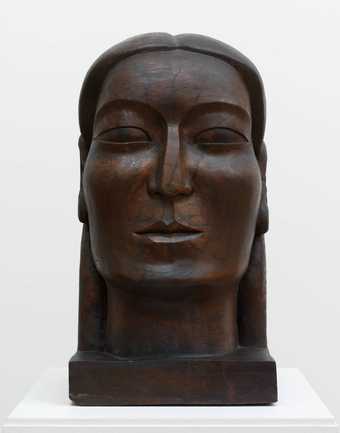
Not on display
- Artist
- Ronald Moody 1900–1984
- Medium
- Elm
- Dimensions
- Object: 1550 × 725 × 388 mm
- Collection
- Tate
- Acquisition
- Purchased 1992
- Reference
- T06591
Summary
Ronald Moody, who was born into a prominent Jamaican family, came to England in 1923 to train as a dentist at the Royal Dental Hospital, London. About 1930, shortly after he had established his dental practice in Cavendish Place, London, he took up sculpture. Without the financial means for a formal training he taught himself first to model in clay and then in the early 1930s to carve. Like Jacob Epstein and Henry Moore, he was profoundly affected by the British Museum’s collection of non-western art. In particular he was interested by ‘the tremendous inner force, the irresistible movement in stillness’ of the Egyptian pieces (quoted in Ann Walmsley, p.2).
Moody was among a small group of artists from the African diaspora, which included the painter William H Johnson and the sculptor Edna Manley, that found a European audience during the pre-war period. In 1935 he exhibited at the Adams Gallery, London and in 1936 at the Walker Art Gallery, Liverpool. A year later in 1937 his sculpture was included in the Tropiques exhibition at Galerie Billiet-Vorms, Paris with work by the Fauve artists Raoul Dufy, André Lhote and Henri Matisse, among others.
The same year Galerie Billiet-Vorms gave him a one-man show in which Johanaan was exhibited for the first time. Displayed as Johanaan L’Evangeliste (St John the Evangelist) it was one of a series of heroic, spiritual figures Moody carved during the 1930s. In January 1938 it was exhibited at the Kunstzaal van Lier, Amsterdam. Later that year his sculptures were included in exhibitions at the Salon des Tuileries and L’Equipe in Paris. These exhibitions received considerable critical acclaim, and soon after Moody moved to Montmartre, where he and his wife, the English painter Helene Coppel-Cowan, lived until the German invasion of France in 1940.
The sculpture was carved directly from a large rectangular block of elm, the only undisturbed remnant of which is the base. The avant-garde vogue for direct carving had emerged at the beginning of the twentieth century as a reaction against a dominant school of academic sculpture based on modelling and casting, which was perceived by some to be mannered and slick. Direct carving was associated with Pre-Renaissance and non-European sculpture. As a practice it was invested with notions of the ‘natural’ and ‘authentic’.
Johanaan’s surface has been carved and polished to achieve a smooth, subtly modulated finish. In some areas the wood’s natural qualities have been exploited to enhance the modelling of the figure. For example, the woodgrain has been used to form the iris and pupil of the left eye; the crack down the centre of the block has been enlarged to supplement the rendering of the navel and the solar plexus. Elsewhere the block’s irregularities have been suppressed, for example, several cracks have been filled and stained by the artist.
The title of the work would appear to be a variant spelling of the biblical Hebrew name Yochanan or Johanan. Though Moody was brought up in the Congregationalist Church, a branch of Protestant Christianity, specific reference to the Christian tradition is rare in his work. His interest in St John was primarily in the contribution his so-called ‘spiritual gospel’ made to the wider philosophy of religions. In the iconography of the Eastern Church the saint is often depicted as an elderly man, bald and bearded, whereas in the Western Church he is usually portrayed as a young man with long hair but beardless.
Further reading:
Ann Walmsley, The Carribean Artists Movement 1966-1972 A Literary & Cultural History, London and Port of Spain 1992, reproduced p.31
The Other Story: Afro-Asian artists in post-war Britain, exhibition catalogue, Hayward Gallery, London 1989, pp.16-19, reproduced as ‘John The Baptist’ p.17 (colour)
Toby Treves
May 2000
Does this text contain inaccurate information or language that you feel we should improve or change? We would like to hear from you.
Display caption
Moody was born in Jamaica in 1900. He came to Britain in 1923, more than twenty years earlier than the other artists in this section. He joined his older brother, Harold Moody, a doctor who co-founded the civil rights organisation, the League of Coloured Peoples in 1931. Moody initially studied dentistry but by the late 1920s, inspired by the art of ancient Egypt in the British Museum, he began exploring sculpture. He turned to wood carving in the 1930s. Named after John the Baptist, Johanaan reveals the influence of the ancient art and spirituality of Egypt, India, and China.
Gallery label, January 2022
Does this text contain inaccurate information or language that you feel we should improve or change? We would like to hear from you.
Explore
You might like
-
Ronald Moody Midonz
1937

